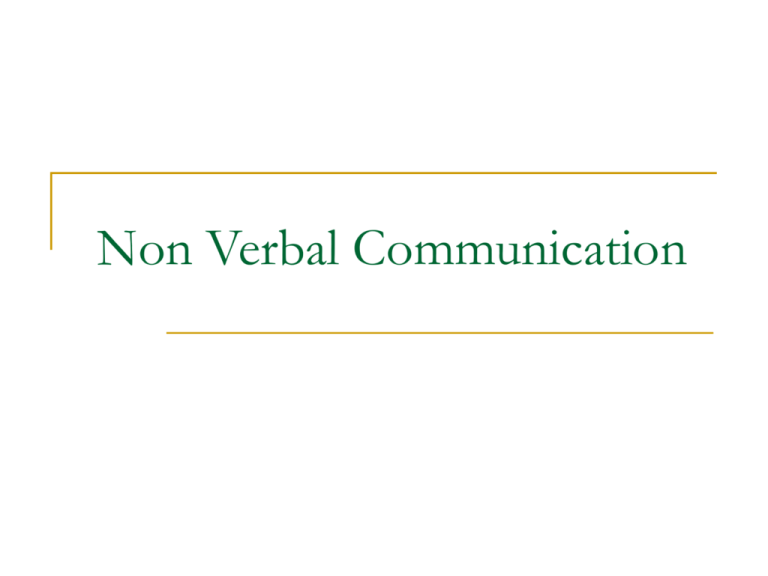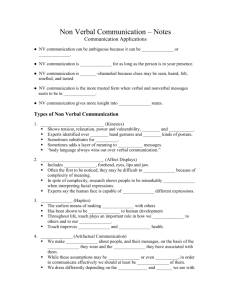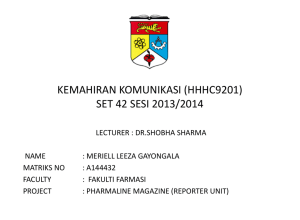Why Study Speech Communication?
advertisement

Non Verbal Communication Non Verbal Communication NV communication can be ambiguous because it can be intentional _________ or ____________. unintentional NV communication is continuous __________ for as long as the person is in your presence. multi NV communication is _____-channeled because clues may be seen, heard, felt, smelled, and tasted. NV communication is the more trusted form when verbal and nonverbal messages seem to be in conflict _______. NV communication gives more insight into emotional _________ states. Types of Non Verbal 1. __________________ Posture and Gestures (Kinesics) Shows tension, relaxation, power and vulnerability, mood _____ and personality __________. Experts identified over 5,000 _____ hand gestures and 1,000 _____ kinds of posture. words Sometimes substitutes for ______. Sometimes adds a layer of meaning to verbal ______ messages. “body language always wins out over verbal communication.” Types of Non Verbal 1. ____________ Face and Eyes (Affect Displays) eyebrows forehead, eyes, lips and jaw. Includes _________, Often the first to be noticed, they may be difficult interpret because of complexity of meaning. to ________ In spite of complexity, research shows people to be remarkably accurate ________ when interpreting facial expressions. Experts say the human face is capable of 250,000 different expressions ________ Types of Non Verbal 1. _____ Touch (Haptics) contact with The earliest means of making _______ others. Has been shown to be essential ________ to human development. Throughout life, touch plays an important role in respond to others and to our how we ________ environment ____________. mental and ________ physical health. Touch improves ______ Types of Non Verbal 1. _______ Clothing (Artifactual Communication) assumptions about people, and their We make ____________ messages, on the basis of the clothing _______ they wear objects they have associated with them. and the _______ While these assumptions may be incorrect ________ or even unfair _____, in order to communicate effectively aware of them. we should at least be ______ situation We dress differently depending on the ________ who we are with. and ____ Types of Non Verbal 1. ________ Distance (Proxemics) The amount of space we maintain between ourselves and the person(s) we are communicating with sends messages about how we feel toward the other(s). Proxemics sends messages about: feel about others at that particular How we ____ time. context of the conversation is. What the _______ goals are. What our personal _____ Four Primary Distance Zones Intimate ________: Touching to 2 ft. confidential This distance is primarily for ____________ exchanges and is almost always reserved for ______ close friends or parent & child. trust It indicates closeness __________ and _____. Personal _________: 2 ft to 4 ft. This is the distance that is comfortable for conversations between friends. This is the most comfortable for most business _________ contact. Four Primary Distance Zones Social ______: 4 ft to 12 ft. This is the ordinary distance people maintain from one another for most social and business _________ exchanges. Public ______: More than 12 ft. At this distance, perhaps in a shopping mall or on the street, people barely ______ acknowledge each other’s presence. At most they give a nod or shake of the head. At this distance communication is not as desirable or possible. Types of Non Verbal 1. _____ Time (Chronemics) “chrono” means time ____. structure time can send The way we use ___ and ________ intentional and unintentional messages about __________ what we value and consider important. Ex. Showing up 20 min. late for an appointment sends the message that you do not value the other person’s time. Types of Non Verbal Paralanguage 1. _____________ _____ How you say something through the use of volume, pitch, rate, and stress. The _____ tone of voice, pauses, and rhythem have something to say, over and above the words themselves. The rate ____ of speech also tells us something about the speaker’s feelings. fast when they are excited or anxious, or People talk _____ when they are trying to persuade us or sell us something. slowly when they are depressed, People tend to talk _______ disappointed or simply tired. Types of Non Verbal 1. _______ Silence Can be comfortable ___________ or ______________ uncomfortable depending on the situation. 2. Physical ______________________ Attractiveness In our society we have norms that dictate what is attractive and what is not. Our media plays on attractiveness and we tend to vale more the words and actions of a person viewed as physically attractive Combines with artifactual _________ communication (clothing) so that we see the attractiveness not only of the person but also of the artifacts they wear. Types of Non Verbal 1. _____________ Environment Depending on your environment you may be happy, _____, afraid stressed, confused, sad, lonely, joyful, content or peaceful.








